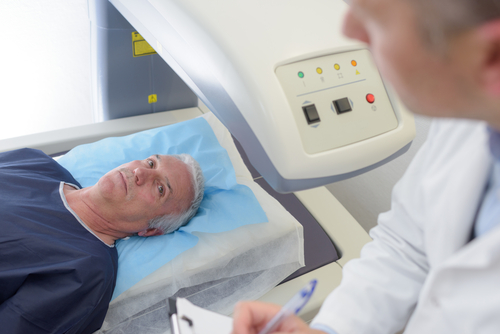Prostate cancer patients who have disease recurrence following radical prostatectomy should undergo imaging scans using the imaging agent 68Ga-PSMA-11 to guide their salvage radiotherapy, a new study suggests.
The study, by researchers at the University of California, Los Angeles shows that the imaging procedure effectively detects the location of recurrence at an early stage. In 19 percent of patients, the scans identified lesions that wouldn’t otherwise be covered by the radiation fields.
The study, “68Ga-PSMA-11 PET/CT Mapping of Prostate Cancer Biochemical Recurrence After Radical Prostatectomy in 270 Patients with a PSA Level of Less Than 1.0 ng/mL: Impact on Salvage Radiotherapy Planning,” was published in The Journal of Nuclear Medicine.
In practice, volume delineations for prostate cancer salvage radiotherapy (SRT) after radical prostatectomy are normally drawn in the absence of radiographically visible disease.
In the absence of visual clues, clinicians delineate a consensus clinical target volume in the prostate and pelvic lymph nodes (areas with potential occult tumor) according to the guidelines of The Radiation Therapy Oncology Group (RTOG) — a panel of experienced genitourinary radiation oncologists.
In the study, researchers retrospectively analyzed positron emission tomography/computed tomography (PET/CT) scans of 270 patients who had biochemical recurrence of prostate cancer after radical prostatectomy, but had not received prior radiotherapy. The scans had been performed using the radioactive agent 68Ga-PSMA, which targets the prostate-specific membrane antigen (PSMA).
The scans were taken when patients had serum PSA levels below 1 ng/ml — a level at which standard of care imaging is insensitive for detecting recurrence.
Importantly, almost half of patients (49 percent) had a positive 68Ga-PSMA PET/CT, and 52 (19 percent) had at least one PSMA-positive lesion that was not covered by the consensus clinical target volume.
The two most frequent 68Ga-PSMA PET-positive lesion locations outside the consensus target fields were bone (44 percent) and perirectal lymph nodes (31 percent).
Taken together, the researchers contend, the results support the use of 68Ga-PSMA PET/CT as a superior imaging technique with potential major impact in improving the planning of salvage radiotherapy in patients with prostate cancer recurrence.
“Salvage radiotherapy is only curative if recurrent disease is completely encompassed by the radiotherapy fields. Therefore, in almost 20 percent of these patients, the addition of PSMA PET/CT would have a potentially major impact on the outcome of salvage radiotherapy,” Jeremie Calais, MD, of UCLA and first-author of the study, said in a press release.
An early detection of cancer recurrence, when PSA levels are still low, increases the chances of success of the radiotherapy treatment. The study shows this could be achieved using 68Ga-PSMA PET scans.
“The first sign of prostate cancer recurrence is a rising PSA. For salvage radiotherapy to be successful, it should be initiated before the PSA rises above 1 ng/mL, and ideally, closer to 0.2 ng/mL or lower,” Calais said.
“Based on European data, we believe that PSMA PET/CT, an imaging technique that is not yet approved by the U.S. Food and Drug Administration, is sufficiently sensitive to detect and localize the recurrent prostate cancer early enough to potentially guide salvage radiotherapy,” he concluded.
For the team, the results also justify a future clinical trial to test if salvage radiotherapy with or without 68Ga-PSMA-11 PET/CT examining its potential benefit on clinical outcome.

